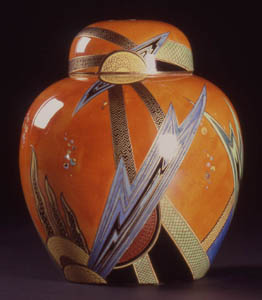![[Metroactive Arts]](/arts/gifs/art468.gif)
[ Arts Index | Silicon Valley | Metroactive Home | Archives ]

Object of Desire: Enoch Boulton's 'Jazz' ginger jar of the 1920s is fancifully decorated with gilt and enamel. Moderne Dreams The Legion of Honor traces the rise of Art Deco By Michael S. Gant SLEEK, OVOID, enameled in bright yellow, with a molded grip handle--the Opco Company ice crusher of 1935 looks like what Buck Rogers would use to make cocktails in the 25th century. As much sci-fi ray gun as household appliance, this wonderful object is as totally desirable and cool a piece of industrial design (by "anonymous," no less) as any iPod. At the current show devoted to the Art Deco period at the Legion of Honor in San Francisco, the Opco ice gun sits in a room full of streamlined wonders from the 1930s: an aluminum and chrome portable record player, a meat slicer that looks ready to break the land speed record and an array of curvilinear radios fashioned from exotic-sounding materials like "plaskon urea formaldehyde" and various permutations of Bakelite. These everyday objects given futuristic sheen represent the democratization of the international style labeled (well after the fact) "art deco." What began around 1910 (and took off in earnest after the upheaval of World War I) as a new approach to the design of luxury goods eventually filtered down to every conceivable consumer item--silverware, table lamps, bed sets, purses, advertisements, textiles. Art Deco started as a reaction against the excesses of Art Nouveau with its tendrils and elaborate swirling motifs. At its most extreme, the movement, taking off from Cubism, verged on a radical stripping away of all decoration, resulting in simplified geometric forms as seen in the architecture of the Bauhaus school. At the same time, Art Deco reveled in an exuberance that culminated in skyscrapers like the Chrysler Building and the Rockefeller Center (represented by the original architectural model) to the neo-Egyptian, neo-Moorish, neo-Mayan movie palaces that popped up in even small-town America in the 1920s and '30s. The earlier objects on display tend to be upper-end items crafted from precious materials like gold, lapis lazuli, jade and platinum. Especially impressive (and ahead of its time) is Josef Hoffmann's silver fruit basket from 1904--an exquisitely spare vase shape that starts from a tiny square base and flares to a wide opening held within a lattice of narrow ribs. Just as refined but far more colorful is Enoch Boulton's Jazz ginger jar, with its enamel and gilt details applied to a stunning orange background. The stylistic developments of the early 1920s culminated in the Paris Exposition of 1925. The exhibit includes samples from the various national pavilions at the exposition, including a number of one-of-a-kind items, like the oversized black-lacquer wardrobe cabinet inscribed with an intricate pattern of silver line work depicting a stylized donkey and hedgehog--a stunningly impractical and riveting piece of design. In the 1930s, Art Deco became a truly global style, permeating every level of design and spread by visions of fanciful interiors constructed on Hollywood back lots for movies like Grand Hotel and the extravaganzas of Busby Berkeley. Pretty soon, the urge to streamline everything extended to cigarette lighters that look like ocean liners and mantel clocks that resemble Babylonian temples. The sense of propulsion that streamlining gave to even mundane objects expressed an urgent optimism that if society just got moving fast enough it could jet out of the Depression. And if that didn't work, at least you could pour yourself a good stiff drink from a cocktail shaker that could do double duty as a rocket ship.
Art Deco: 1910-1939 runs through July 4 at the Legion of Honor, Lincoln Park, 100 34th Ave., San Francisco. (415.750.3614)
Send a letter to the editor about this story to letters@metronews.com. [ Silicon Valley | Metroactive Home | Archives ]
|
From the May 12-18, 2004 issue of Metro, Silicon Valley's Weekly Newspaper.
Copyright © Metro Publishing Inc. Metroactive is affiliated with the Boulevards Network.
For more information about the San Jose/Silicon Valley area, visit sanjose.com.